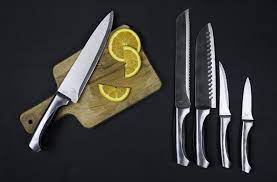Your Cart is Empty
FREE Worldwide Shipping! | +1 365 654 6605
FREE Worldwide Shipping! | +1 365 654 6605
February 22, 2024 3 min read

Do you ever find yourself confused about the plethora of knives available in the market and wonder which ones are truly essential for your kitchen? We have got you covered! In this comprehensive guide, we will discuss the five essential types of kitchen knives that you should own, along with their uses and maintenance tips. Before we dive into the specific types of knives, it's important to understand that each knife serves a unique purpose and contributes to the efficiency of your cooking process. As the saying goes, "The right tool for the right job" - this applies to kitchen knives as well. From slicing a loaf of bread to dicing a juicy tomato, the right knife can make a world of difference. Arguably the most versatile tool in your kitchen, a chef's knife is the first knife you should invest in. An 8-10 inch chef's knife is recommended for its versatility and efficiency. Chef's knives are primarily used for most of the slicing and dicing tasks in the kitchen. They are perfect for chopping vegetables, slicing fruits, and cutting meat and fish. However, they are not suitable for tasks like butchering or carving poultry or for peeling large vegetables. Investing in a chef's knife is worth it as it's the tool you'll be using the most. Look for a high-quality chef's knife that costs around $100. Remember, a good knife should last forever if maintained properly. A paring knife, with a blade length of about 3 1/2 inches, is perfect for tasks that require attention to detail. This knife is ideal for slicing and mincing items that are too small for an 8- to 10-inch blade, such as mincing garlic, hulling strawberries, or peeling fruits and vegetables. A good-quality paring knife can be bought for about $20. Opt for a metal blade for a longer lifespan. Also known as a bread knife, a serrated knife has a toothed blade suitable for jobs not suited to the straight blade of a chef's knife. Serrated knives are especially useful for foods with waxy surfaces, such as tomatoes, pineapples, watermelons, citrus, and peppers. They're also great for slicing cake layers. For a good-quality serrated knife, you can expect to pay between $30 and $40. If well maintained, a serrated knife will stay sharp for years. A boning knife is a sleek, slim knife used for cutting up or boning fish, meat, or poultry of any size. The boning knife is perfect for anything with a ribcage and joints, requiring a blade that can flex to cut around the bones and slice through joints and cartilage. You should plan to spend about $30 for a good-quality boning knife, with potential to invest more if you'll be using it heavily. While not a knife, a honing steel is an essential tool for maintaining the sharpness of your knives. A honing steel is used to realign the teeth or fibers on the blade, leading to a sharper edge and a cleaner cut. It should be used every time you use your knives. A quality honing steel should cost you about $25, and it can be either a ceramic or steel model. So, there you have it - a comprehensive guide to the five essential kitchen knives that everyone should own. Remember, the right knife can make your cooking process easier, faster, and more enjoyable. Choose wisely and keep them well maintained for a seamless cooking experience.Introduction
Chef's Knife
Overview
Uses
Maintenance
Paring Knife
Overview
Uses
Maintenance
Serrated Knife
Overview
Uses
Maintenance
Boning Knife
Overview
Uses
Maintenance
Honing Steel
Overview
Uses
Maintenance
Conclusion
References
Be the first to know about upcoming sales and promos. Get a 10% discount coupon when you subscribe!